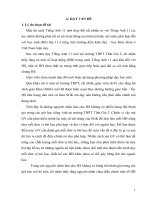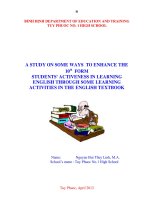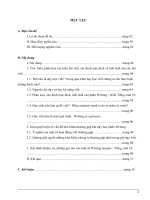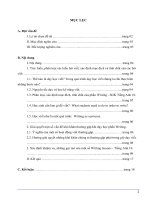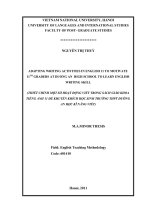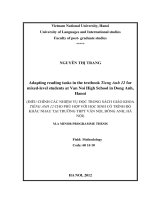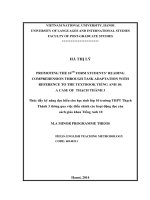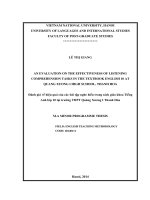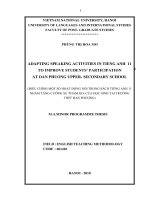Thiết chỉnh một số hoạt động viết trong sách giáo khoa Tiếng Anh lớp 11 để khuyến khích học sinh trường THPT Đường An học kĩ năng viết
Bạn đang xem bản rút gọn của tài liệu. Xem và tải ngay bản đầy đủ của tài liệu tại đây (410.47 KB, 66 trang )
VIETNAM NATIONAL UNIVERSITY, HANOI
UNIVERSITY OF LANGUAGES AND INTERNATIONAL STUDIES
FACULTY OF POST- GRADUATE STUDIES
*********************
NGUYỄN THỊ THUÝ
ADAPTING WRITING ACTIVITIES IN ENGLISH 11 TO MOTIVATE
11
TH
GRADERS AT DUONG AN HIGH SCHOOL TO LEARN ENGLISH
WRITING SKILL
(THIẾT CHỈNH MỘT SỐ HOẠT ĐỘNG VIẾT TRONG SÁCH GIÁO KHOA
TIẾNG ANH 11 ĐỂ KHUYẾN KHÍCH HỌC SINH TRƯỜNG THPT ĐƯỜNG
AN HỌC KĨ NĂNG VIẾT)
M.A.MINOR THESIS
Field: English Teaching Methodology
Code: 601410
Hanoi, 2011
VIETNAM NATIONAL UNIVERSITY, HANOI
UNIVERSITY OF LANGUAGES AND INTERNATIONAL STUDIES
FACULTY OF POST- GRADUATE STUDIES
*********************
NGUYỄN THỊ THUÝ
ADAPTING WRITING ACTIVITIES IN ENGLISH 11 TO MOTIVATE
11
TH
GRADERS AT DUONG AN HIGH SCHOOL TO LEARN ENGLISH
WRITING SKILL
(THIẾT CHỈNH MỘT SỐ HOẠT ĐỘNG VIẾT TRONG SÁCH GIÁO KHOA
TIẾNG ANH 11 ĐỂ KHUYẾN KHÍCH HỌC SINH TRƯỜNG THPT ĐƯỜNG
AN HỌC KĨ NĂNG VIẾT)
M.A.MINOR THESIS
Field: English Teaching Methodology
Code: 601410
Supervisor: Nguyễn Thị Thơm Thơm, MA
Hanoi, 2011
iv
LIST OF ABBREVIATIONS
CLT: Communicative Language Teaching
MOET: The Ministry of Education and Training
ESL/ EFL: English as a Second Language or a Foreign Language
ELT (English Language Teaching)
v
LIST OF TABLES and Figures
Table 1:
Differences between Process Approach and Product Approach……………….8
Table 2:
Checklist of writing tasks in English textbook 11.………………………………22
Table 3:
The average marks of the control and experimental group…………….………28
Table 4:
The average marks of the control and experimental group before the
experiment.……………………………………………………………………………30
Table 5:
Students’ motivation in learning writing English ……………….………………31
Table 6:
Students’ participation in writing lessons.………………………………… ……31
Table 7:
Factors prevent students from participating in writing in the class.……….….32
Table 8:
Students’ opinions towards English writing skills in the textbook English 1….33
Table 9:
Students’ opinion about the way their teachers teach writing…………… ……33
Table 10:
Students’ evaluation towards their current writing lessons………………… …34
Table 11:
Results of experimental group’s participation………………………………….…42
Table 12:
Students' range in the two classes before and at the end of experiment.………43
Figure 1:
The material evaluation process……………………………………………………14
Figure 2:
A preliminary framework for materials analysis and action……………………15
vi
TABLE OF CONTENTS
DECLARATION……………………………………………………………… ……. …….i
ABSTRACT……………………………………………………………………………… ii
ACKNOWLEDGEMENTS……………………………………………… iii
LIST OF ABBREVIATIONS ……………………………………………… iv
LIST OF TABLES AND FIGURES ………………………………………………………v
TABLE OF CONTENTS………………………………………………………………… vi
PART A: INTRODUCTION……………………………………………… … ….… 1
1. Rationale for the study…………………………………………………………… … 1
2. Research questions …………………………………………………………………….2
3. Aims of the study ……………………………………………………………………. 2
4. Scope of the study…………………………………………………………………… 2
5. Methods of the study………………………… …………………………. ………… 2
6. Design of the study……………………………………………………………………. 3
PART B: DEVELOPMENT………………………………………………………………4
CHAPTER 1: LITERATURE REVIEW……………………………………………… 4
1. An Overview of Writing…………………………………………………………… 4
1.1. Definitions of writing………………………………………………………………… 4
1.2. Roles of writing……………………………………………………………………… 4
1.3. Approaches to teaching writing…………………………………………………… 6
1.4. Writing teaching procedure………………………………………………………… 9
2. An Overview of Motivation ………………………………………………………… 9
2.1 Definitions of motivation…………………………………………………………… 9
2.2 Roles of motivation…………………………………………………………………. 10
2.3. Types of Motivation…………………………………………………………………. 10
3. Materials Evaluation…………………………………………………………………. 13
3.1. The concepts of materials evaluation…………………………………………… 13
3.2. The reasons for materials evaluation……………………………………………… 13
3.3. Models for evaluation………………………………………………………………. 13
3.4. Criteria for evaluation……………………………………………………………… 16
4. Material adaptation…………………………………………………………………. 16
4.1. Definition of material adaptation…………………………………………………… 16
4. 2. The purpose of adaptation………………………………………………………… 17
4.3. Techniques for adaptation………………………………………………………… 18
vii
4.4. Levels of adaptation………………………………………………………….…… 19
CHAPTER 2: THE STUDY……………………………………………………………. 21
2.1. Research setting…………………………………………………………………. 21
2.1.1. The setting of the study………………………………………………… … 21
2.1.2. Writing materials…………………………………………………………… 21
2.2. Research design……………………………………………………………………23
2.3. Participants……………………………………………………………………… 24
2.4. Data collection instruments……………………………………………………….25
2.4.1. Classroom observations…………………………………………………… 25
2.4.2. The teacher interview……………………………………………………… 26
2.4.3. Student questionnaire………………………………………………………. 26.
2.4.4. Follow-up student interview………………………………………………….26
2.5. Data collection procedure…………………………………………………… … 27
CHAPTER 3: DATA ANALYSIS AND FINDINGS………………………………….28
3.1. The students' level and motivation before the experiment…………………… 28
3.2. Results from questionnaire………………………………………………………. 30
3.3. Results from teacher interview………………………………………………… 34
3.4. Results from the end of experiment observations……………………………….37
3.4.1. Observations in control group…………………………………………… …37
3.4.2. Observations in experimental group…………………………………………37
3.5. Students’ participation in experimental and control group in three lessons at the
end of the intervention…………………………………………………………………42
3.6. Comparison of students’ participation in experimental and control group … 43
3.7. Follow-up student interview…………………………………………………… 44
PART C: CONCLUSION……………………………………………………………… 45
1.1. Summary of the study……………………………………………………………….45
1.2. Implications…………………………………………………………………………45
1.3. Limitations of the study …………………………………………………………….46
1.4. Suggestions for further study ……………………………………………………….46
REFERENCES …………………………………………………………………………47.
APPENDICES
1
Part A: Introduction
1. Rationale of the study
The introduction of new English 10, 11, 12 textbook to school curriculum in 2006,
2007 and 2008 has marked a dramatic change in the way English is taught. Along with
three skills, namely, speaking, listening, reading, writing has been put in priority and
integrated in the textbook.
Although the books have shown a great deal of improvement as compared with
the old series of grammar-based it seems that not all activities or tasks in the books,
especially in writing part are suitable to the different teaching and learning contexts of
different localities within Vietnam.
After 5 years teaching new English 11 at Duong An high school, I find out that in
comparison with other three skills, writing is considered the most complicated to teach and
still remains neglected due to students‟ low level proficiency, time constraints and low
motivation. When students write, they find themselves confused with word choice,
grammatical use, organization and generation of ideas. They tend to translate ideas from
mother tongue into English, express ideas in long sentences, and are not aware of different
kinds of writing, thus making them unable to write in real life. Because of limited
background knowledge, they often feel bored and do not want to write. Naturally, teaching
English writing in upper-secondary schools is a challenging job for many English teachers
because it requires not only high language competence among the teachers themselves, but
also the application of appropriate writing instruction. Some teachers do not feel confident
about their own English and shy away from designing writing tasks or getting students to
write more than just grammatical exercises. Sometimes teachers do not have enough ideas
to facilitate students. In reality, most teachers follow what the tasks in the textbook require,
and do nothing more about it. They may even let students copy the models from the guide
books or sample collection.
On realizing students‟ problems, I assume that what English writing teachers need
to do is to improve the quality of students‟ pieces of writing, to give them a more
cooperative learning environment, and to motivate them to participate in the writing
lessons. I myself have been making an effort to seek pedagogical methods which could
help deal with the mentioned problems. What is more, I suggest that adapting writing
2
activities in textbook could be a more effective strategy. Many studies on the effectiveness
of this have proved that it can be applied in ELF writing classes to solve the above
problems. However, I have not found any research on this field in upper-secondary schools
in Vietnam in general and in Hai Duong in particular so far. Related to my students‟
problems, I would like to conduct an experimental study titled “Adapting writing
activities in English 11 to motivate 11th graders at Duong An high school to learn
English writing skill” in order to inspire our students in writing lessons.
2. Aims of the study
The study aims at:
- investigating teachers‟ and students' attitudes towards teaching and learning writing at
Duong An high school.
- determining the effect of the adapted activities in motivating students at Duong An high
school in writing lessons. Basing on the findings, some implications and suggestions will
finally be proposed by the researcher.
3. Research questions
With the above aims, the research questions are:
1. What are teachers‟ and students' attitudes towards teaching and learning writing
at Duong An high school?
2. How do the adapted activities help motivate students at Duong An high school in
writing lessons?
4. Scope of the study
There is a variety of aspects affecting students‟ motivation in class activities so
there exist numerous methods to improve students‟ involvement. However, it is not my
attention to cover all of them because of time and length constraint of the study.
Adaptation of several writing activities in English 11 is focused on and tested in class 11A
at Duong An high school. As the result, the samples of the study were restricted to 4
teachers and 40 students at 11th form at Duong An high school.
5. Methods of the study
The method employed in this study is a quasi- experimental research to identify the
teachers' and students' attitude towards teaching and learning writing skill. After that found
3
out the reasons why teachers should adapt activities in English 11 to motivate students at
Duong An high school in writing lesson. The study attempts to find out whether the
adapted activities can motivate students or not.
Data were collected by means of textbook evaluation, interviews, questionnaires,
and observations and experiment. Concerning interviews, 4 teachers who have ever taught
English 11 were involved in the study. Survey questionnaires were conducted among 40
students from two classes at the school.
6. Design of the study
This minor thesis is divided into three main parts.
Part A, INTRODUCTION, presents the rationale, the aims, scope, methods, and
design of the study. The research questions are also mentioned in this part.
Part B, DEVELOPMENT, consists of three following chapters:
Chapter one, Literature Review, presents various concepts most relevant to the
research topic such as definitions of writing, roles of writing, approaches to writing
teaching, writing teaching procedure; concepts of motivation in language teaching and
learning; materials evaluation. Furthermore, the following are also included in this chapter:
Definition of material adaptation, the purpose of adaptation, techniques for adaptation and
levels of adaptation as well.
Chapter two, namely “THE STUDY” describes the overall picture of the research
was carried out from the first step of determining the research design to the last step of
gathering the results. Moreover, presentation of statistical results are describes in this
chapter
Chapter three, “DATA ANALYSIS AND FINDINGS” analyses the collected data
to answer the two research questions.
Part C, CONCLUSION, addresses the key issues in the study, summaries some
limitations revealed during the process of the completing this study.
4
PART B: DEVELOPMENT
CHAPTER 1: LITERATURE REVIEW
1. An Overview of Writing
1.1. Definitions of writing
Writing is one of the four language skills (speaking, listening, reading and writing) that a
learner is expected to master. Writing has been defined in a variety of ways. Firstly,
writing is the process in which the writer expresses his thoughts or ideas in the form of
handwriting. “Writing is communicating. Good writing gets your ideas out of your head
and into the reader‟s head without losing or distorting those ideas” (Leki, 1976). As for
Tribble, writing is “a language skills which is difficult to acquire” (1996, p. 3). He also
stressed that writing “normally requires some forms of instruction” and that “it is not a
skills that is readily picked up by exposure” (1996, p. 11). From my personal experience as
a classroom teacher, I share with Rivers‟ definition (1981) that “writing is not a skill that
can be learned or developed in isolation but it should be taught and developed in
cooperation with other skills and aspects of the language studied.” Furthermore, writing is
a productive skill, so it is writing that provides students with chances to put the language
itself and practice communicative skills at the same time. Through the act of writing
students will realize what they are already good at and what they still need to learn to
become better.
1.2. Roles of writing
Writing emerges with its own functions and brings along communicative code of
the writers. When making a piece of writing, the writer implies a message or a certain
purpose. In the modern world, writing (written language) serves a range of functions in
everyday life. As Nunan (1991:84) aptly points out, writing is:
(i) Primarily for action: public signs (on roads and stations), product labels and
instructions (on food, tools or toy purchased), recipes, maps, television and radio
guides, bills, menus, telephone directories, etc.
(ii) Primarily for social contact: personal correspondence, letters, postcards,
greeting cards.
(iii) Primarily for information: newspapers and magazines, non- fiction books
(textbooks, public notices, advertisement, guidebooks and travel literature, etc.)
5
(iv) Primarily for entertainment: light magazines, comic strips, fiction books,
poetry and drama, film subtitles, games including computer games.
In classroom, teaching and learning writing also plays an important role. Through
writing, learners are able to share ideas, arouse feelings, persuade and convince other
people. We are able to discover and articulate ideas in the way that only writing makes
possible. Therefore, writing has always occupied a place in the language syllabus.
Discussing about this issue, White (1981, p. 1) points out a number of reasons why writing
merits a place in the language syllabus as follows:
(i) Writing remains the commonest way of examining students‟ performance in
English (all public examinations include a composition). Consequently, ability to
write remains a key to examination success.
(ii) In the eyes of both parents and students, ability to write may be associated with
evidence of having learnt the language. Writing is tangible parents and students
can see what has been done and what has been achieved. So it has high „face
validity‟.
(iii) In classroom, writing may be used as one of a number of techniques to help
add variety and interest to lesson.
(iv) Teachers may use writing as a testing device to provide feedback on what
students have learnt. Students‟ writing can provide useful evidence of successes or
failures in learning, of confusions, and errors.
(v) Writing requires thought, discipline and concentration. It is relatively a
permanent form and readers judge us by our style, content and logic. So writing
demands care and thought.
In CLT, the teaching of writing also aims at communication. However, besides
being used to communicate, writing helps students learn. In Raimes‟ opinion (1983, p.3),
“first writing reinforces the grammatical structures, idioms and vocabulary that students
have been taught. Second, when students write, they also have a chance to be adventurous
with the language, to go beyond what they have just learnt to say, to take risks. Third,
when they write, they necessarily become very involved in the new language, the effort to
express ideas, and the constant use of eyes; hand and brain is a unique way to reinforce
learning”.
6
With all the roles mentioned above, writing really becomes an integral part in almost every
language syllabus from elementary to tertiary level.
1.3. Approaches to teaching writing
It is confirmed that teaching and learning writing is really complicated work. For
students, they must have knowledge of content, organization, discourse, syntax, lexis, and
mechanical elements. For teachers, they may be confused of a variety of approaches. In
other words, approaches to teaching ESL/ EFL writing have long been a topic of
controversy for them, even for researchers. It is being taught in many different ways, and
each approach can be effective, if the teacher believes in what he or she teaches. Ann
Raimes (1983, pp. 5- 10) presents six following approaches to teaching writing:
(i) The Control - to- Free Approach
The Control- to- Free Approach in writing is sequential. In this approach, writing is
considered as a reinforcement means of speech and is used to master grammatical or
syntactic rules. At lower level, students are often given sentence- level exercises or
controlled compositions to imitate, copy or manipulate. Students, therefore, make few
mistakes. Only at high or advanced level are students allowed to try some free
compositions, in which they can express their own ideas.
In short, this approach emphasizes accuracy rather than fluency. Syntax and
mechanics are main stresses of the approach.
(ii) The Free- Writing Approach
Contrast to the Control- to- Free Approach, the Free- Writing Approach focuses
more on fluency, and quantity of writing than quality. Students are assigned a vast amount
of free writing on given topics with only minimal correction of errors. They are allowed to
write freely without worrying about grammar and spelling. Content and fluency are taken
into account first.
(iii) The Paragraph- Pattern Approach
Different from the two approaches mentioned above, the Paragraph- Pattern
Approach stresses on paragraph organization. Students copy a model paragraph, analyze its
form and then write a parallel one. In this approach, students are provided with such kinds
of exercises as sentence ordering, sentence inserting or sentence deleting, etc.
(iv) The Grammar- Syntax- Organization Approach
7
The name „the Grammar- Syntax- Organization Approach‟ fully reveals the
characteristics of the approach. Writing cannot be seen as composed of separate skills
which are learned one by one. Students need to pay attention to organization while they
also work on the necessary grammar and syntax. For example, to write a clear set of
instructions on how to use a phone card, the writer needs more than the appropriate
vocabulary. He needs the simple forms of verbs, an organizational plan based on
chronology; sequence words like first, then, next, etc. In the preparatory stage, these
vocabulary and structures are reviewed and taught. In general, this approach is the
combination of the purpose and the form of the writing.
(v) The Communicative Approach
The Communicative Approach aims at communicative competence, so it stresses
the purpose of the writing and the audience for it. Students are regarded as writers in real
life and they are encouraged to ask themselves the key questions: What am I writing for?
(purpose) and who will read it? (audience). Conventionally, the teacher acts as the
audience for students‟ writing. However, to make it more real- life- closed communication,
students become readers for each other. They read each other‟s writings, respond, rewrite
in another form or make comments, but not correct. Sometimes the teacher creates a
context in which students are real readers by making them role- play, exchange letters,
reply, ask questions and comment.
(vi) The Process Approach
The teaching of writing has recently moved away from a concentration on the
written product to an emphasis on the process of writing, which leads to the emergence of
Process Approach. Process Approach to writing came into play in the 1970s. This
approach encourages students‟ communication of ideas, feelings and experiences. It is
more global and focuses on purpose, theme, text type, i.e. the reader is emphasized. Thus,
writers not only concern about purpose and audience but also have to make decisions on
how to begin and how to organize a piece of writing. Writing is a process, so students are
given time to set out ideas, make plan, write a first draft, revise what has been written after
a peer feedback, then they can edit their writing or write other drafts before the final
version is produced. Brown (1994, pp. 335- 336) points out some features of Process
Approach as follows:
(1) focus on the process of writing that leads to the final written product
8
(2) help students understand their own composing process
(3) help them to build repertoires of strategies for prewriting, drafting, and
rewriting
(4) give students time to write and rewrite
(5) place central importance on the process of revision
(6) let students discover what they want to say as they write
(7) give students feedback throughout the composing process (not just the final
product) as they attempt to bring their expression closer and closer to attention
(8) encourage feedback from both the instructor and peers
(9) include individual conferences between teacher and students during the process
of composition
There are various approaches to teaching writing as mentioned. It is true to say that
there is not necessarily any „right‟ or „best‟ way to teach writing skills.
Comparing the Product Approach and Process Approach, Steele summarizes their
differences in the table below:
Process writing
Product writing
* text as a resource for comparison
* ideas as starting point
* more than one draft
* more global, focus on purpose, theme,
text type, i.e., reader is emphasized
* collaborative
* emphasis on creative process
* imitate model text
*organization of ideas is more important
than ideas themselves
* one draft
* features highlighted including controlled
practice of those features
* individual
* emphasis on end product
Table 1: Differences between Process Approach and Product Approach
From the analysis and the comparison of the two approaches, it is undeniable that
each approach has its own strengths and weaknesses. It is also the fact that there are few
classrooms where teachers are devoted to one approach as to exclude all others. Normally,
they still use techniques drawn from other approaches as the students need them and those
techniques are useful in the context of the class. The writing lessons in new English 11
textbook were compiled following both Product Approach and Process Approach. This
Combined Product- Process Approach is found to be more popular, appropriate and
9
effective. The suggested general outline for a writing lesson following this approach may
be: Stage 1: A model is given.
Stage 2: Students work on the model, analyze its typical features, and pay attention to
the language and structure of the model.
Stage 3: Students work in groups/ pairs to find out the ideas for the writing topic/ task
and produce an outline.
Stage 4: Students write the first draft individually/ in pairs/ in groups. The model is
used for comparison.
Stage 5: Drafts are exchanged. Students give comments on each other‟s work.
Stage 6: Drafts are returned and changes or improvements are made based on peer
feedback.
Stage 7: Students write final drafts.
Stage 8: Final drafts are exchanged once more; students give response or reply to each
other.
Stage 9: Teacher gives feedback.
1.4. Writing teaching procedure
According to Brown (1994), teachers should follow the teaching procedure including
two main stages: Pre- writing and While- writing. This procedure is a combination of
different approaches, especially the communicative approach and the process approach.
(i) Pre- writing
- Exploiting the model text in terms of form, vocabulary, grammar, organization, etc.
- Defining the task such as describe , write a letter of
- Limit the topic
- Generate the ideas
(ii) While- writing
- Draft
- Revise
- Write the final version
2. An Overview of Motivation
2.1 Definitions of motivation
10
There have been so far many researches on the theory of motivation. Each author has
his/her own way of explaining what motivation is since they look at motivation from
different angles. However, motivation is generally defined as an abstract concept used to
describe the willingness of a person to expand effort to reach a particular goal
According to Carol (1962), motivation decides the amount of time a learner will spend on
the task of language learning. She claims: “The more motivation a learner has, the more
time he or she will spend on learning an aspect of a second language” (Carol, 1962).
Crookes and Schmidt (1991) define motivation in terms of students' interest in and
enthusiasm for the materials and activities used in class, their persistence with the learning
task as indicated by levels of concentration and enjoyment. Learning is only effective if
students enjoy activities and work hard.
Among what have been mentioned, Crookes and Schmidt‟s definition is chosen to use in
this thesis because of two reasons. First, it is directly related to the process of teaching and
learning language which emphasizes the important roles of students. Theoretically, when
students are interested in the activities and are persistent with the learning tasks, they will
get better results in learning. Second, it is similar to what would be studied in the research
project that the researcher wants to examine the students‟ interest, satisfaction and
concentration on the varied activities in class, so the working definition in the thesis is:
motivation is interest in and enthusiasm for the activities used in classrooms, attention or
levels of concentration, the effort and persistence with the learning tasks as well as the
challenge of the activities conducted by the teachers. This definition will guide the
researcher to design a questionnaire survey to get the information about the students‟
learning motivation in the research.
2.2. Roles of motivation
It can be concluded that motivation is significant in foreign language learning because
when learners set the goal of learning a foreign language, motivation helps them produce
effort and have a positive attitude to obtain the goal. Therefore, in order to be successful,
language learners really need motivation to continue their learning. Motivation not only
plays an important role in learning, it helps the teacher as well. Lite (2002) confirms that
11
“Motivation is the backbone of any classroom. When the students are motivated, the
teacher can perform his/her job the best.”
Teachers are often familiar with two basic types of motivation: extrinsic motivation and
intrinsic motivation. Harmer (2001) states that extrinsic motivation is caused by such
outside factors as the need to pass an exam, the hope of possibility for future travel, etc. In
contrast, intrinsic motivation is caused by inside factors like the enjoyment of the learning
process itself or by a desire to make themselves feel better.
2.3. Types of Motivation
According to theorists, there are some distinctions of types of motivation in foreign
language learning: integrative and instrumental motivation; intrinsic and extrinsic
motivation
2.3.1. Integrative vs. instrumental motivation
2.3.1.1. Integrative motivation
One form of motivation is known as integrative motivation. It is thought that students
who are most successful when learning a second language are those who like the
people who speak that target language, admire the culture and have a desire to
become familiar with the society in which the language is used (Falk, 1978). This
kind of motivation is considered a key component in assisting learners to develop
some level of proficiency in L2 when they become residents in the community in
which the target language is used in social interactions.
According to Gardner and Lambert (1974: 98) “An integrative orientation involves
an interest in learning an L2 because of a sincere and personal interest in the people
and culture represented by the other language group”. It occurs when learners wish to
identify with the culture of the L2 group
2.3.1.2. Instrumental motivation
In contrast to integrative motivation is instrumental motivation. This is characterized
by the desire to obtain something practical from the study of L2 (Hudson, 2000).
With this kind of motivation, the purpose of L2 acquisition is more utilitarian. Ellis
(1994: 75) mentioned “some functional reasons such as to pass an examination, to
get a better job, or to get a place at university. These reasons motivate learners to
learn an L2 because it opens up educational and economic opportunities for them”.
12
Instrumental motivation is often a characteristic of L2 acquisition, where little or no
social integration of the learner into a community using the target language takes
place.
Littlewood (1998) replicating Gardner and Lambert (1972), concluded “ A learner
with instrumental motivation is more interested in how the second language can be a
useful instrument towards furthering other goals, such as gaining a necessary
qualification or improving employment prospects” (1998: 57). It occurs when
learners‟ goals for learning an L2 are functional. With an instrumental motivation,
learners can be successful in learning an L2. It is likely that incentives like money
can help learning, but the effects maybe cease as soon as the reward stops.
In short, Learners can have both integrative and instrumental motivation. In some
cases, integrative may be more powerful in stimulating L2 learning, in some other
situations, however, instrumental counts far more. In addition, the social contexts in
which learning takes place strongly influence the level and type of motivation.
2.3.4. Intrinsic motivation vs extrinsic motivation
2.3.4.1. Intrinsic motivation
Intrinsic motivation refers to “motivation to engage in an activity for its own sake”
(Woldkowski, 1991). He means that activity itself is our benefit, so we do not need
any other kinds of rewards or punishment. He states that intrinsic motivation “is the
natural tendency to seek out and conquer challenges as we pursue personal interests
and exercise capabilities”. The factors of support of intrinsic motivation are:
competence (feeling that you know how to do things), autonomy (being able to
perform an activity by yourself without external help) and relatedness (connection
with your social environment like helping the others).
2.3.4.2. Extrinsic motivation
Harmer (2001:51) gives an easily understandable definition that extrinsic motivation
“is caused by any number of outside factors such as: the need to pass an exam, the
hope to of financial reward or possibility of future travel”.
Most writers agree that intrinsic and extrinsic motivations interact with each other
and play an important role in language learning. As a result, learners can be either
motivated by internal or external factors depending on the circumstances and
conditions under which the activity is performed.
13
3. Materials Evaluation
3.1. The concepts of materials evaluation
There are many ways of defining evaluation. Nunan (1988) suggests that evaluation be “a
process not a final product” that means it takes place at any time of the material design.
The first and foremost emphasis of evaluation is to determine whether the goals and
objectives of a language program are being attained.
According to Tom Hutchinson and Waters (1993) evaluation is really a matter of judging
the fitness of something for a particular purpose. “Given a certain need, and in the light of
the resources available, which out of number of possibilities can represent the best
solution? There is no absolute good or bad- only degrees of fitness for the required
purpose”.
From the above definitions, it can be inferred that materials evaluation involves the
determination of what needs to be evaluated, the objectives and requirements for the
materials, and the judgments of the value of the materials being evaluated in relation to the
objectives and requirements determined.
3.2. The reasons for materials evaluation
There are two main reasons for carrying out materials evaluation. Firstly, there may be a
need to choose among the materials available the most suitable ones to use for a particular
situation. Secondly, there can be a need for materials evaluation to determine whether the
material which has been chosen works for that situation after it has been used for a period
of time (Ellis, 1997).
Robinson (1991) adds, evaluation can be used as part of quality control. Through
evaluation, we can know about the advantages and disadvantages as well as the
effectiveness of the being used materials. Then we can decide whether the materials can be
reused or whether it needs to be adapted to meet the need of the particular teaching
situation or we need to change it absolutely.
In short, the findings of materials evaluation will provide input for responsible people to
evaluate the effectiveness of the materials.
3.3. Models for evaluation
According to Hutchinson and Waters (1987), evaluation is a process of matching needs to
available solutions. Thus, the evaluation process is divided into four steps as follows:
14
- Defining criteria
- Subjective analysis
- Objective analysis
- Matching
The above steps are presented in the following diagram as the following:
Figure 1: The material evaluation process
(Cited from Hutchinson and Waters, 1987, p. 98)
In Hutchinson and Waters‟ view, a teaching material in general and a course book
in particular has to suit the needs of a number of parties such as teachers, students,
sponsors, so it is important that the subject factors should not be allowed to obscure
objectivity in the early stages of analysis. In order to have an objective matching, it is
advisable to look at the needs and solutions separately. However, in the final analysis, any
choice will be made on subjective ground.
DEFINE CRITERIA
On what bases will you judge material?
Which criteria will be more important?
SUBJECTIVE ANALYSIS
What realizations of the criteria do you
want in your course?
OBJECTIVE ANALYSIS
How does the material being evaluated
realize the criteria?
MATCHING
How far does the material match
your needs?
15
Another author, Littlejohn (1998) introduces the framework as follows:
Figure 2: A preliminary framework for materials analysis and action
(Cited from Littlejohn, 1998)
It can be demonstrated from the above diagram that the two steps of describing the
target situation and analyzing materials are conducted spontaneously and independently.
The next step is matching and evaluation in which the level of appropriateness to the target
situation is discussed. In the last step, the decision on materials is made.
Obviously, although these two models consist of different steps, they both set out
the way to evaluate the material. Based on the above discussion, the materials evaluation
model suggested by Hutchinson and Waters is chosen as the framework for evaluation in
this study.
ANALYSIS OF TARGET
SITUATION OF USE
- The cultural context
- The institution
- The course (proposed aims,
content, methodology, measures
of evaluation)
- The teachers
- The learners
MATERIALS ANALYSIS
From analysis:
1. What is their explicit nature?
2. What is required by users?
3. What is implied by their use?
To description:
- aspects of design
- aspects of publication
MATCH AND EVALUATION
How appropriate are the respects of design and the aspects of
publication to the target situation of use?
ACTION
Adopt the materials
Reject the materials
Adapt the materials
Supplement the materials
Make the materials a critical object
16
3.4. Criteria for evaluation
Various scholars have suggested different ways to help evaluators become more systematic
and objective in their method of evaluation by using a checklist.
Hutchinson and Waters (1987, p.99-104) suggest five evaluation criteria for objective and
subjective analysis as follows:
- Audience: the learners and the materials intended for
- Aims: the aims of the course and the aims of the materials
- Content: language description, language points, proportion of work on each macro-skill,
text-types, subject-matter areas, level of knowledge, types of topics, treatment,
organization of content within the course units, sequence of content throughout the course,
sequence of content within a unit
- Methodology: theory of learning, learners‟ attitudes, kinds of exercises, teaching-
learning techniques, aids, guidance/ support for teaching, the flexibility of materials
- Other criteria: price, quantities, availability
Another list of evaluation criteria is presented by Sheldon (1988). It consists of: rationale,
availability, user definition, layout/ graphics, accessibility, linkage, selection/grading,
physical characteristics, appropriacy, authenticity, sufficiency, cultural bias, education
validity, stimulus/ practice revision, flexibility, guidance, and overall value for money. He
also emphasizes that in different situations, upgrading, modification and extension to these
criteria are needed to suit the specific requirements.
To sum up, in this thesis the researcher used the evaluation model by Hutchinson
and Waters because the criteria defined by Hutchinson and Waters appeared to be more
manageable and suitable to the objectives of the current study.
4. Material adaptation
4.1. Definition of material adaptation
As far as we know, adaptation plays a very important role in foreign language teaching
I myself believe that a good teacher is constantly adapting. In reality, no textbook can
totally be an effective tool for teachers to follow without any adaptation because of the
disadvantage of the textbook such as linguistic inaccuracies, out-of-datedness, lack of
authenticity or lack of variety. Adaptation is to compensate for those deficiencies. There
are a number of definitions of adaptation given by different scholars.
17
In their book “Materials and Methods in ELT” (1993), McDonough and Shaw devote a
chapter to the issue of adaptation materials. They quote Madsen and Bowen‟s definition
(1978: ix) “one or more a number of techniques: supplementing, editing, expanding,
personalizing, simplifying, modernizing, localizing, or modifying, or modifying cultural/
situational content”.
Similarly, from Tomlinson‟s point of view (1998: xi), adaptation is referred to
“reducing, adding, omitting, modifying and supplementing”. He supposes that most
teachers adapt materials every time they use a textbook in order to maximize the value of
the book for their particular learners. More or less, most of the scholars‟ viewpoints, which
I base my thesis on, agree on some kind of change and addition when mentioning
“adaptation”.
4. 2. The purpose of adaptation:
There are always sound practical reasons for adapting materials in order to make
them as accessible and useful to learners as possible. However, reasons for adaptation have
varied and changed as the field has developed and views on language acquisition and
teaching practice have become better informed by research and experience. There are two
most frequently cited purposes for adaptation:
1. to make the material more suitable for the circumstances in which it is being used,
i.e. to mould it to the needs and interests of learners, the teachers' own capabilities
and such constraints as time, or as Mc Donough and Shaw (1993:85) put it: “to
maximize the appropriacy of teaching materials in context, by changing some of
the internal characteristics of a course book to better suit our particular
circumstances”
2. to compensate for any intrinsic deficiencies in the materials, such as linguistic
inaccuracies, out-of-datedness, lack of authenticity (Madsen and Bowen 1978) or
lack of variety.
Looking deeper into McDonough and Shaw‟s definition of purpose we see that
maximizing the appropriacy of teaching materials (by, e.g., modifying them in such a way
that they seem more relevant to learners' interests and needs) is important because it can
stimulate motivation, and increased motivation is in turn likely to lead to a classroom
atmosphere more conductive to learning. In fact, when teachers make changes to a course
18
book “to better suit our particular purposes” what teachers are really trying to do is to
improve students‟ participation to increase the effectiveness of the learning experience.
4.3. Techniques for adaptation
4.3.1 Adding
The notion of addition is that materials are supplemented by putting more into them, while
taking into account the practical effect on time allocation. First, we can certainly add in
this quantitative way by the technique of extending “This means that the techniques are
being applied within the methodological framework of the original materials: in other
words, the model is not itself changed” (McDough and Shaw, 1993: 89). We can do this in
the following situation: A second reading passage parallel to the one provided is helpful in
reinforcing the key linguistic features- tenses, sentence structures, vocabulary, cohesive
devices – of the first text. Second, more far-reaching perspective on addition of materials
can be termed expanding. This kind of addition is not just extension of and existing aspect
of content. They go further than this by bringing about a qualitative as well as a
quantitative change…This can be thought of as a change in the overall system”
(McDonough and Shaw, 1993:90).
4.3.2 Deleting or Omitting
Deletion is clearly the apposite process to that of addition. As can be seen in the previous
section that materials can be added both quantitatively (extending) and qualitatively
(expanding), the same point applies when a decision is taken to omit materials. The most
straightforward aspect of reducing the length of materials is subtracting.
Addition and deletion often work together. Material may be taken out and then replaced
with something else. The methodological change is greater when, for example, grammar
practice is substituted after the omission of an inappropriate communicative function, or
when a reading text is replaced by a listening passage.
4.3.3 Modifying
Modifying can be sub-divided under two related headings. The first of these is
rewriting, when some of the linguistic content needs modification, the second is
restructuring, which applies to classroom management.
- Rewriting may relate activities more closely to learners' own background and interest,
introduce model of authentic language, or set most purposeful problem-solving tasks
where the answers are not always known before the teacher asks the question.
19
- Restructuring: For many teachers who are required to follow a course book rather
strictly, changes in the structuring of the class are sometimes the only kind of adaptation
that is realistically possible. For example, the materials may contain role-play activities
for groups of certain size.
4.3.4. Simplifying
The technique of simplification is a type of modification, namely a “rewriting” activity.
The elements of a language which can be simplified are: The instructions and explanations
that accompany exercises and activities, and even the visual layout of materials so that it
becomes easier to see how different part fit together. However, texts, most often reading
passages are applied this technique. Usually, the emphasis has been on changing various
sentences- bound elements to match the text more closely to the proficiency level of a
particular group of learners.
4.3.5. Re-ordering
This procedure refers to the possibility of putting the parts of a course book in a different
order. This may mean adjusting the sequence of presentation within a unit, or taking units
in a different sequence from that originally intended.
4.4. Levels of adaptation
Textbook adaptation can be done at three levels. The first level is macro
adaptation, which is ideally done before the language program begins. After comparing
what is covered in a textbook and what is required by the syllabus or examination, the
teacher may find that certain areas or even whole unit of the book can be omitted, and
certain contents need to be supplemented.
The second level of adaptation is adapting a unit. This could be reordering the
activities, combining activities, omitting activities, rewriting or supplementing exercise
material, etc. Unit adaptation helps to make the classroom teaching more smooth and
cohesive. It also helps the teacher to better fulfill the aims of a unit.
The third level is adaptation of specific activities in a unit. Occasionally an activity
I regarded as valuable, but it is not well-designed or it is not feasible in particular class. If
the teacher does not want to give up the activity, he or she needs to adapt it.
5. Summary
To conclude, this chapter has so far touched upon issues relating to the topic of the
study. It has discussed definitions of writing, roles of writing, approaches to writing
